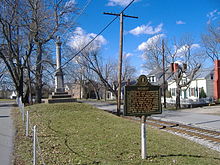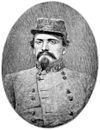
Frankfort is the capital city of the U.S. state of Kentucky and the seat of Franklin County. It is a home rule-class city. The population was 28,602 at the 2020 United States census. Located along the Kentucky River, Frankfort is the principal city of the Frankfort, Kentucky Micropolitan Statistical Area, which includes all of Franklin and Anderson counties. It is the fourth smallest state capital city in the United States by population.

Georgetown is a home rule-class city in Scott County, Kentucky, United States. The population was 37,086 at the 2020 census. It is the 6th-largest city by population in the U.S. state of Kentucky. It is the seat of its county. It was originally called Lebanon when founded by Rev. Elijah Craig and was renamed in 1790 in honor of President George Washington. It is the home of Georgetown College, a private liberal arts college. Georgetown is part of the Lexington-Fayette, KY Metropolitan Statistical Area. At one time the city served as the training camp home for the NFL's Cincinnati Bengals.
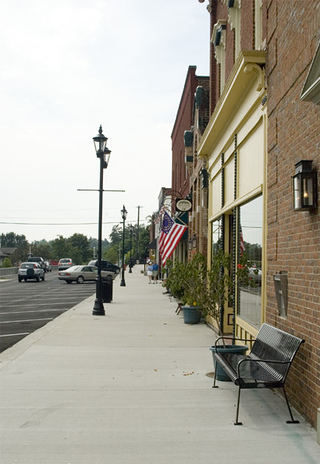
Midway is a home rule-class city in Woodford County, Kentucky, in the United States. Its population was 1,741 at the time of the year 2020 U.S. census. It is part of the Lexington-Fayette Metropolitan Statistical Area.
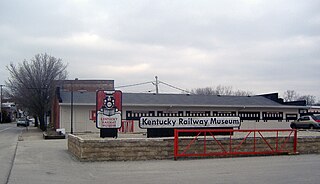
The Kentucky Railway Museum, now located in New Haven, Kentucky, United States, is a non-profit railroad museum dedicated to educating the public regarding the history and heritage of Kentucky's railroads and the people who built them. Originally created in 1954 in Louisville, Kentucky, the museum is at its third location, in extreme southern Nelson County. It is one of the oldest railroad stations in the United States.

Crescent Hill is a neighborhood four miles (6 km) east of downtown Louisville, Kentucky USA. This area was originally called "Beargrass" because it sits on a ridge between two forks of Beargrass Creek. The boundaries of Crescent Hill are N Ewing Ave to the St. Matthews city limit by Brownsboro Road to Lexington Road. Frankfort Avenue generally bisects the neighborhood.

The Flim-Flam Man is a 1967 American comedy film directed by Irvin Kershner, featuring George C. Scott, Michael Sarrazin, and Sue Lyon, based on the 1965 novel The Ballad of the Flim-Flam Man by Guy Owen. The movie has well-known character actors in supporting roles, including Jack Albertson, Slim Pickens, Strother Martin, Harry Morgan, and Albert Salmi.

The Thomas Viaduct spans the Patapsco River and Patapsco Valley between Relay, Maryland and Elkridge, Maryland, USA. It was commissioned by the Baltimore and Ohio Railroad (B&O); built between July 4, 1833, and July 4, 1835; and named for Philip E. Thomas, the company's first president. Some claim it to be the world's oldest multiple arched stone railroad bridge. However, the Sankey Viaduct on the Liverpool and Manchester Railway was opened in 1830, and finally completed in 1833.

The Frankfort Cemetery is a historic rural cemetery located on East Main Street in Frankfort, Kentucky. The cemetery is the burial site of Daniel Boone and contains the graves of other famous Americans including seventeen Kentucky governors and a Vice President of the United States.
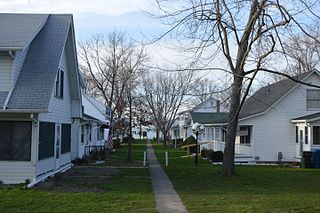
The 103rd Ohio Infantry Regiment, sometimes 103rd Regiment, Ohio Volunteer Infantry was a three-years' infantry regiment from northeastern Ohio that served in the Union Army during the American Civil War. It participated in many of the campaigns and battles of the Army of the Ohio in the Western Theater.

John Rudolph Niernsee was an American architect. He served as the head architect for the Baltimore and Ohio Railroad. Rudolph also largely contributed to the design and construction of the South Carolina State House located in Columbia, South Carolina. Along with his partner, James Crawford Neilson, Rudolph established the standard for professional design and construction of public works projects within Baltimore and across different states in the United States.

The Martyrs Monument in Midway, located in Midway City Cemetery outside Midway, Kentucky, was placed on the National Register of Historic Places on July 17, 1997, as part of the Civil War Monuments of Kentucky Multiple Property Submission. It honors four Confederate prisoners who were killed due to the standing order of Union General over Kentucky Stephen G. Burbridge, known as Order No. 59, which declared: "Whenever an unarmed Union citizen is murdered, four guerrillas will be selected from the prison and publicly shot to death at the most convenient place near the scene of the outrages." The Confederate prisoners, whose names were M. Jackson, J. Jackson, C. Rissinger, and N. Adams, were executed on November 5, 1864 northeast of Midway, the precise location of which is unknown. This was due to the actions of Sue Mundy, a former trooper under John Hunt Morgan who terrorized Union forces in Kentucky during the later years of the American Civil War. They were buried in shallow graves originally, then re-buried in a Presbyterian cemetery, and finally in 1890 moved to their current location, with the dedication of the Martyrs Monument.

In mid-May 1861, U. S. Navy lieutenant William "Bull" Nelson armed Kentuckians loyal to the Union and that soon became the foundation for his receiving authority to enlist 10,000 troops for a campaign into East Tennessee. On August 6, 1861, those recruits marched into Camp Dick Robinson, making it the first Federal base south of the Ohio River. For Col. George C. Kniffen, "the wisdom of President Lincoln commissioning. .. Nelson to organize a military force on the [neutral] soil of Kentucky" prevented making the state a "battle ground for many months" and it thereby changed the whole direction of the war. In 1864, Salmon P. Chase declared in a speech at Louisville "when Kentucky faltered, hesitated" in the early stages of the Civil War, that undecided "status was settled by WILLIAM NELSON, at Camp Dick Robinson." Six years later, Indiana Senator Daniel D. Pratt reported to the U. S. Senate that Camp Dick Robinson "was one of the most noted military encampments of the war.. .. From its admirable locality and advantages, it was almost indispensable for the successful operations of the" Civil War.

The following is an alphabetical list of articles related to the United States Commonwealth of Kentucky.
The Lexington and Ohio Railroad was the first railroad in the U.S. Commonwealth of Kentucky. Its charter proposed the establishment of a link between Lexington in the center of the Bluegrass Region to the river port of Louisville at the Falls of the Ohio by way of Frankfort, the state capital. The line was never completed and the Panic of 1837 led to its complete collapse. The Commonwealth seized the railroad in payment of its debts in 1840.
The Louisville and Frankfort Railroad (L&F) was a 19th-century railroad in the U.S. state of Kentucky.
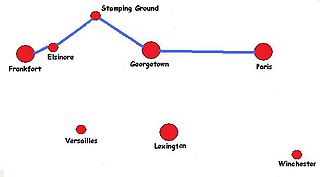
The Frankfort and Cincinnati Railroad is a defunct shortline railroad based in Kentucky. Despite its name, it had no connections with Cincinnati, Ohio.
The following is a timeline of the history of Lexington, Kentucky, United States.
The Civil War Trust's Civil War Discovery Trail is a heritage tourism program that links more than 600 U.S. Civil War sites in more than 30 states. The program is one of the White House Millennium Council's sixteen flagship National Millennium Trails. Sites on the trail include battlefields, museums, historic sites, forts and cemeteries.

